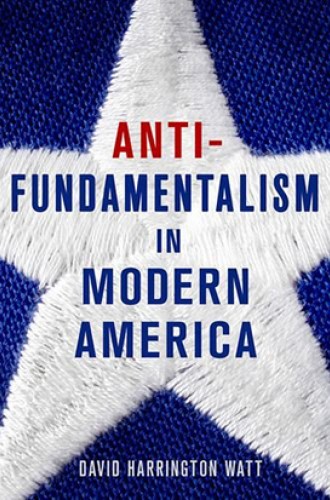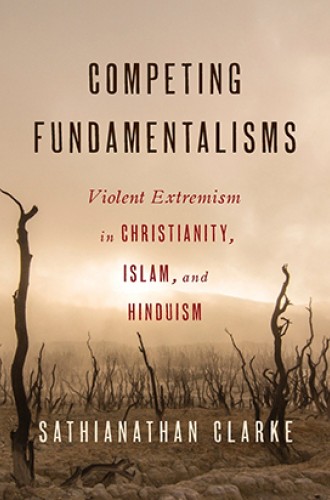Will the real fundamentalists please stand up?
What counts as fundamentalism? David Harrington Watt and Sathianathan Clarke give contrasting answers.
The terms fundamentalist and fundamentalism originally referred to a particular movement of conservative Protestants in early 20th-century America. But in recent decades, they have been frequently applied far beyond this context.
This shift raises multiple questions. Is it appropriate to use the term fundamentalist to describe Jews in the haredim movement, or conservative Catholics who prefer the Latin Tridentine Mass, or proponents of Hindutva (“Hinduness”) in India? Since Muslims view the Holy Qur’an as the Word of God, is it proper to view all Muslims as fundamentalists—or should one apply this term only to some Muslims, or to none? Can the term fundamentalist be accurately applied to historical figures, as James Simpson does to 16th-century English Reformers in his book Burning to Read? Moving further back in time, do we gain insight if we apply the term to perspectives in the New Testament, as in William R. G. Loader’s description of Jesus’ alleged rejection of “the fundamentalism of his day, which was obsessed with literal fulfillment”?
Read our latest issue or browse back issues.
Even if we confine our focus to the United States alone, the significance of the term fundamentalist can be elusive, particularly regarding its relation (or lack thereof) to evangelical Christianity. George M. Marsden famously described a fundamentalist as “an evangelical who is angry about something” and noted that Jerry Falwell had accepted this description. More recently, however, Timothy Kelly has puzzled over the shifting meaning of his self-description as an evangelical in relationship to fundamentalism. “When I used the word [evangelical] to describe myself in the 1970s, it meant I was not a fundamentalist. If I use the name today, however, it means to hearers that I am” (New Yorker, December 19, 2017).
Amid this complexity, David Harrington Watt and Sathianathan Clarke each address the question of whether it is proper to apply the term fundamentalist to religious movements outside of Christianity. They give directly contrasting responses.
Watt, who teaches history and American religions at Temple University, studies Protestant fundamentalists and their opponents in the United States. His book offers a helpful and reliable survey of the debate over the various meanings of the term fundamentalism, as well as analysis and criticism of these meanings. Watt attributes the origin of the term fundamentalist to Curtis Lee Laws, who used it in 1920 in a positive sense to describe true Christians who were faithful to the fundamentals of their faith. As he traces the history of controversy over fundamentalism in the United States, Watt cautions that some critics made charges that did not accurately apply to all the persons they were attacking, although later scholars writing about fundamentalism frequently accept these polemics at face value. For example, theologians Harry Emerson Fosdick, Kirsopp Lake, and H. Richard Niebuhr presented somewhat condescending descriptions of fundamentalists as bound to the past.
Watt stresses the central role of Talcott Parsons in shifting the discussion from theological critiques to a more ambitious sociological model: “a general theory of fundamentalism” as “a quasi-philosophical category that could be used to identify a set of extraordinarily dangerous tendencies.” Parsons viewed fundamentalists as resentful and rejecting of the modern rationalism of society. For him, fundamentalism was not specifically Protestant. It was a more diffuse and nebulous option for all those who distrusted and resented modernity. This characterization opened the door to wider applications of the term.
Parsons was very influential on Martin E. Marty and the shaping of the Fundamentalism Project, a wide-ranging global study led by Marty and R. Scott Appleby that published six volumes between 1987 and 1995. Even though this noted study helped popularize the term fundamentalism on the global stage, many critics expressed doubts about the appropriateness of expanding a term originally used for some American Protestants to include other religious practitioners who differ in many important ways. Watt likens the question of which Muslims should be viewed as fundamentalists to a hypothetical query about which Christians should be viewed as Sunni or Shi’a—the choice of options is simply not helpful.
Watt notes that the entire series of volumes in the Fundamentalism Project did not include a single essay by a self-described fundamentalist, and he charges that these authors bypassed the questions posed by poststructuralists and postmodernists. He points out that relatively few people today identify themselves as fundamentalists, estimating that approximately 100,000 Protestants and maybe 10,000 Mormons accept the term as a self-designation. He explains that in light of criticisms, Appleby, together with Gabriel Almond and Emmanuel Sivan, eventually decided to reserve the term fundamentalist for Jews, Christians, and Muslims, refusing to apply it to people of other religious traditions.
Watt offers a most discerning account of these debates. After carefully reviewing the arguments pro and con, he concludes very persuasively that the global usage of the term distorts more than it illuminates. As a result, he rejects the expansive usage of the term fundamentalism as not helpful or appropriate.
However, efforts to control the use of terms are notoriously difficult to enforce, and discussion of global fundamentalisms continues unabated. Undeterred by the criticism of scholars like Watt, Clarke argues that he can clearly identify fundamentalisms in Christianity, Islam, and Hinduism. As a presbyter of the Church of South India who teaches theology, church, and mission at Wesley Theological Seminary in Washington, D.C., Clarke has written extensively on India’s Dalits (also called Scheduled Castes, formerly called “untouchables”).
Closely related to the current debate over terminology is the question of how to understand the relation between religious traditions, including fundamentalism, and violence. The disputes over Protestant faith and practice in 1920s America did not involve religiously motivated violence against any government, group, or society; whatever militancy the original fundamentalists displayed was strictly verbal. Today’s usage, however, often applies the term fundamentalist to militant movements that use religious claims to justify the use of indiscriminant violent force.
Clarke’s subtitle suggests an identity between “competing fundamentalisms” and “violent extremism.” Continuing the practice of making broad negative generalizations about fundamentalisms, Clarke launches his discussion with an ominous warning: “Religious fundamentalisms or extremisms—oftentimes grounded in fiery worldviews, sometimes legitimated by furious gods and goddesses, and always marshaling violent disciples—are taking on new birth and demonstrating effectual growth on our contemporary world stage.”
Clarke describes fundamentalism as “religion stretched to its extremes” and focuses especially on “the theory and practice of violent religious fundamentalism.” Aware of various social scientific explanations of fundamentalism, he seeks to identify “its religious features” and interpret it “against the currents of present-day globalization” in service of this pointed agenda: “to challenge and transform this destructive religion.” Citing the Fundamentalism Project as a model and drawing upon its description of “strong religion,” Clarke focuses on Christian fundamentalism in the United States, Islamic fundamentalism in Egypt, and Hindu fundamentalism in India.
Clarke is aware of the debates over the use of the term fundamentalism, and he proposes his own resolution in relation to the three movements under consideration. He views each religion as having “a primordial world vision rooted in a revelation in Word from the Divine.” Further, he argues that each of these fundamentalisms is marked by three theological characteristics:
(1) unwavering confidence in and complete submission to the Word-vision (the word of God as revealed in sacred scriptures), (2) fixed and straightforward world-ways (mandated individual and group behavior), and (3) an imperial global-order (the mission to proselytize and dominate the rest of the world).
Clarke views each of his three fundamentalisms as “a surrogate religion” that warps authentic religious practice. He relates the extreme competitiveness of militant movements to the aggressive spirit of globalization, drawing upon psychological explanations of violent fundamentalism as arising from a sense of alienation and humiliation, which gives rise to anger and hatred directed at other communities viewed as enemies. He notes some important differences among these movements, but his primary concern is to point out areas of convergence.
Like other theorists, Clarke sees Protestant American fundamentalism as emerging in rebellion against secularism and modernity—especially the theory of evolution and historical criticism of the Bible—and developing a vision of America as a militant “Redeemer nation” after 9/11. But whereas Watt carefully distinguishes among a variety of American Protestants who in different contexts have been viewed as fundamentalists, Clarke makes generalizations about American Christian fundamentalists without the same level of attention to differences and nuances.
Turning to Islam, Clarke is careful to insist that fundamentalism is a reactive modern movement that should not be projected back into the origins of Islam. After identifying the birth of Islamic fundamentalism in Egypt with Hassan al-Banna’s organizing of the Muslim Brotherhood in 1928, he identifies two forms of Islamic fundamentalism today: nonstate actors who commit acts of “cruel and spectacular violence,” and Islamic states (such as Saudi Arabia, which perpetrates “systemic violence” as it disseminates “its toxic version of Islam”).
While there have been countless recent descriptions of Christian and Islamic fundamentalisms, many American Christians may be less familiar with the Hindu nationalist movement known as Hindutva. Clarke’s description of this important development may be for many the greatest contribution of his book. Like American Protestant fundamentalism and the Egyptian Muslim Brotherhood, the Hindutva movement took shape in the 1920s, during the period of struggle against British rule in India.
One of the movement’s decisive early leaders, Vinayak Damodar Savarkar, was an atheist, which poses the intriguing question: Can one be an atheistic fundamentalist? Clarke observes that Savarkar viewed Hinduness as uniting the people of India in a motherland, a common blood, and a common culture, with a sense of manifest destiny leading to political militancy. In the 1930s, Savarkar admired and publicly praised Adolf Hitler. Savarkar vilified Muslims and Christians in India for not sharing the common Hindu civilization. Exacerbating the conflict was the fact that by the early 20th century many of India’s Muslims and Christians came from the Dalit and Adivasi (tribal) communities. Hindu nationalists today frequently charge that “forced conversions” led Dalits and Adivasis to embrace Christianity or Islam. Some seek to “reconvert” these people to Hindism, although many Dalits and Adivasis claim that they never identified themselves as Hindus.
Hindu nationalists claim that India should be for the Hindus. All others should endure a subordinate status and in principle should assimilate to the one Hindu national identity. After independence from Britain, Prime Minister Jawaharlal Nehru’s pluralistic, secular vision of India guided the Indian National Congress Party and the Indian nation for many years. In the 1980s, however, as many Indians became disenchanted with the Indian National Congress Party, the Hindutva movement gained increasing support. The BJP (Bharatiya Janata Party), which rules India today, emerged from the Hindutva movement in 1980 and implements its program in the political sphere.
Noting the difference between Hindu fundamentalism and the Abrahamic traditions, Clarke stresses the Hindu fundamentalist view of the body of God as manifesting itself in the concrete social order of the caste system to which humans should conform: “Thus the orderly organization and functioning of human society, as designed by god at creation, is what matters to a fundamentalist Hindu.” Hindu fundamentalists believe that all humans should accept their place in the social order formed by the material body of God in the world. Further, they see this divine social body as under siege today. Clarke identifies the roots of Hindu fundamentalist violence in concern for maintaining and defending this order against attack. He mentions the bloody riots against Christians in the Kandhamal District of the Indian state of Orissa in 2007–08, as well as many other attacks on non-Hindus in India. Tensions and violent conflicts continue between Hindu nationalists and those whom they see as threats to the religious-social order: Muslims, Christians, Dalits, and Adivasis. As Clarke warns, “dissenting Dalits and nonconforming Muslims and Christians are in jeopardy.”
After he describes the three “competing fundamentalisms,” Clarke’s central concern is pastoral. He sets forth a program of action for Christians and partners in other religious traditions, urging them to challenge each element of the fundamentalist agendas and unleash religion’s constructive power. Clarke emphasizes the importance of scriptural interpretation for each of these fundamentalisms, and he calls for a process of “detoxifying scripture” in each tradition. As a Christian, he appeals to the historical Jesus to resist apocalyptic, exclusivist, and fundamentalist views of Christian faith. He calls for “restorative readings” of biblical texts that authorize violence, retelling the stories to promote peace. Clarke hopes that Muslim and Hindu partners can do likewise with their respective scriptures, but he does not want to give them advice on how they should proceed.
Instead of aggressive, competing fundamentalisms, Clarke hopes for a world of “completing religions” that can “make room for God’s overflowing plenitude.” Despite the continuing difficulties of using the term fundamentalism, Clarke offers a significant contribution to our understanding of these situations, especially in India.
A version of this article appears in the print edition under the title “Who can be a fundamentalist?”








